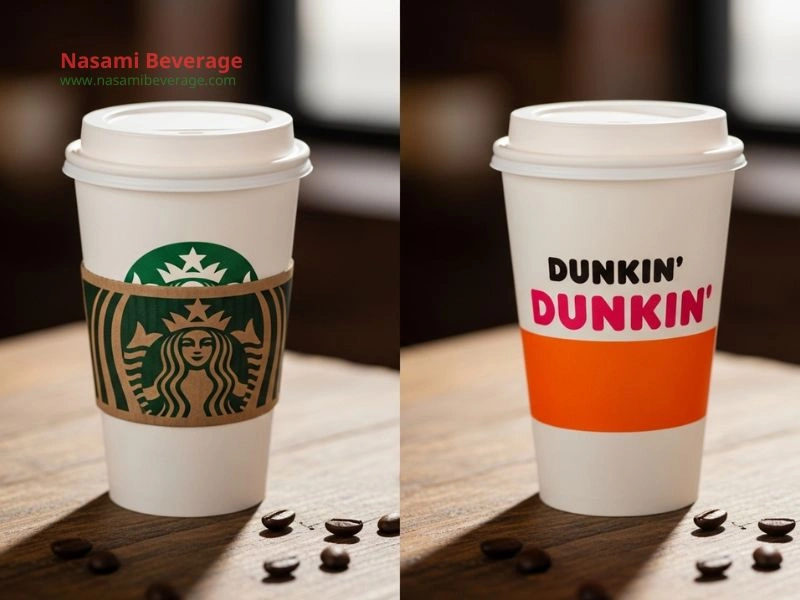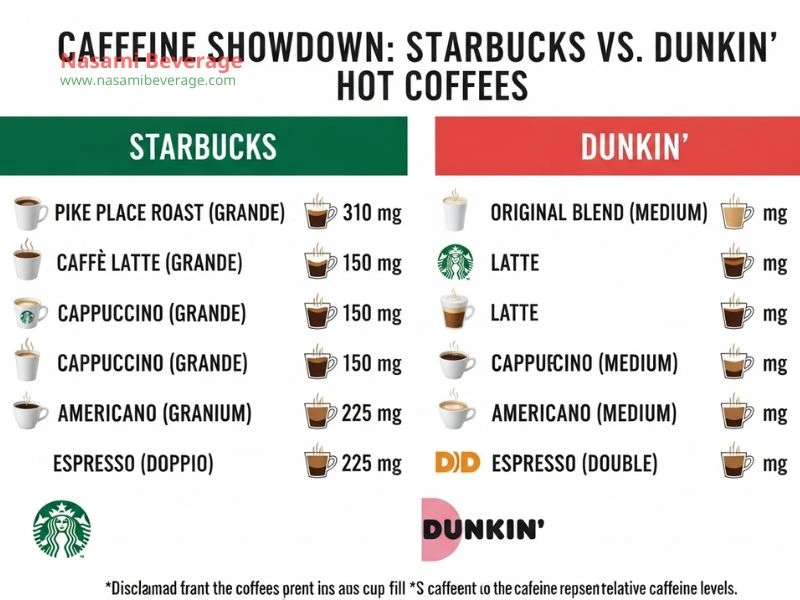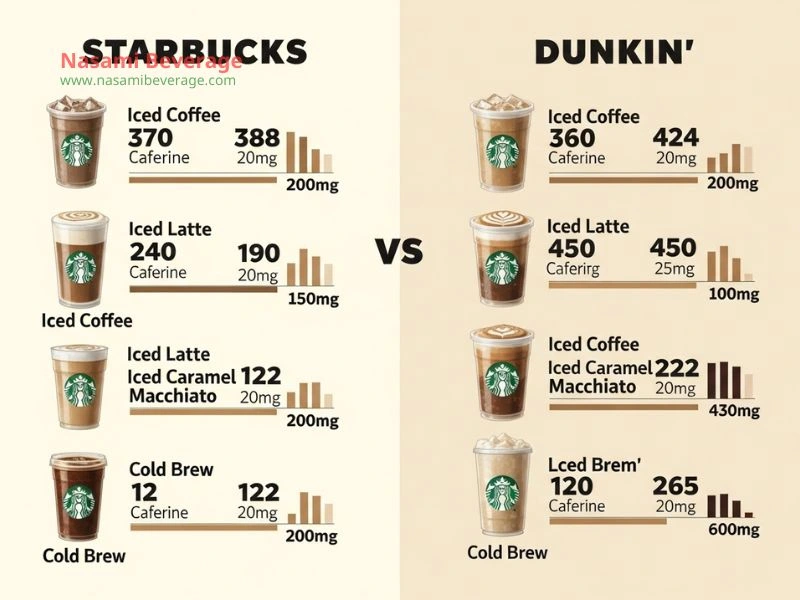For millions, the day doesn’t officially start until they’ve had their first cup of coffee. The rivalry between the two titans of the American coffee scene, Starbucks and Dunkin’, is legendary. While some are loyal to a brand for its flavor, and others for its price, a huge number of coffee lovers are chasing one thing: caffeine. Here at Nasami Beverage, we know a thing or two about quality drinks, and today we’re diving deep into the great debate over the caffeine in Starbucks vs Dunkin’ coffee to see who really delivers the biggest buzz for your buck.

The Great Caffeine Debate: An Overview
Before we jump into the numbers, let’s talk about why this comparison is so important to so many people. Is it just about getting the strongest jolt possible, or is there more to it?
Why Caffeine Content Matters to Coffee Drinkers
Caffeine is the world’s most popular psychoactive drug, and for good reason. It’s a powerful stimulant that can increase alertness, improve focus, and even enhance physical performance. For a student cramming for an exam, a professional facing a long day of meetings, or a parent juggling a hectic schedule, the amount of caffeine in their morning cup can make all the difference.
Knowing which coffee shop offers a more potent brew allows consumers to make an informed choice to meet their energy needs. Beyond just the jolt, many are also curious about the health benefits of coffee and want to manage their intake responsibly.
A Quick Look at How We’re Comparing Starbucks and Dunkin’
To make this a fair fight, we’re comparing similar drink types and sizes. We’ll look at the most popular choices: classic hot brewed coffee, iced coffee, and espresso-based beverages.
We’ll primarily compare a Starbucks “Grande” (16 oz) with a Dunkin’ “Medium” (14 oz), but we’ll also break it down by the ounce to see who is truly more potent.
Caffeine Showdown: Hot Brewed Coffee

This is the classic, the go-to, the standard-bearer for both chains. If you just walk in and ask for a “regular coffee,” this is what you’ll get. So, how does the caffeine in Starbucks vs Dunkin’ coffee stack up in its most basic form?
Starbucks’ Pike Place vs. Dunkin’s Original Blend
The results here are quite staggering. A Grande (16 oz) Pike Place Roast from Starbucks contains approximately 310 mg of caffeine. In contrast, a Medium (14 oz) Original Blend from Dunkin’ has about 210 mg of caffeine. Even with a slightly smaller cup size, Dunkin’s offering has significantly less caffeine.
Caffeine by the Ounce: A Direct Comparison
To level the playing field, let’s look at the caffeine content per fluid ounce:
- Starbucks Pike Place: ~19.3 mg/oz
- Dunkin’ Original Blend: ~15 mg/oz
Verdict: Who Wins for a Standard Cup of Joe?
When it comes to a standard cup of hot brewed coffee, Starbucks is the undisputed champion. If your primary goal is to maximize your caffeine intake with a simple drip coffee, Starbucks gives you nearly 100 mg more in a comparable size.
Iced Coffee Caffeine Levels: A Surprising Twist
When the weather warms up, millions switch to iced coffee. You might assume the caffeine story stays the same, but you’d be in for a surprise. The brewing process for iced coffee is different, leading to a complete reversal of our findings.
Starbucks Iced Coffee vs. Dunkin’ Iced Coffee
A Grande (16 oz) Iced Coffee from Starbucks contains around 165 mg of caffeine. Now, let’s look at Dunkin’. A Medium (14 oz) Iced Coffee from Dunkin’ boasts a whopping 297 mg of caffeine. This isn’t a small difference; it’s a massive gap.
The Cold Hard Facts: Caffeine in Different Sizes
The difference is so stark it’s worth highlighting. You get almost double the caffeine in a Dunkin’ Medium Iced Coffee compared to a Starbucks Grande. This is because Dunkin’ uses a double-brewing process for its iced coffee to ensure the flavor isn’t diluted by melting ice, which results in a much more concentrated, highly-caffeinated beverage.

Verdict: The Iced Coffee Caffeine Champion
For those who prefer their coffee chilled, Dunkin’ is the clear winner by a huge margin. If you need a serious afternoon pick-me-up on a hot day, a Dunkin’ Iced Coffee is one of the most potent options available.
Espresso-Based Drinks: Lattes, Macchiatos, and More
What about drinks built on shots of rich, concentrated espresso? Here, the caffeine content is a bit more standardized, but there are still key differences to note.
Caffeine in a Shot of Espresso: Starbucks vs. Dunkin’
The foundation of any latte or macchiato is the espresso shot itself. Here’s how they compare:
- Starbucks Espresso Shot: ~75 mg per shot.
- Dunkin’ Espresso Shot: ~98 mg per shot.
Interestingly, a single shot of espresso at Dunkin’ is more caffeinated than one from Starbucks.
Comparing Popular Espresso Beverages
Most standard lattes and cappuccinos in a Grande/Medium size at both chains are made with two espresso shots. So, a Grande Caffe Latte from Starbucks will have about 150 mg of caffeine (2 shots x 75 mg).

A Medium Latte from Dunkin’ will have about 196 mg (2 shots x 98 mg). The difference comes directly from the potency of the initial shot.
Verdict: Which Chain Gives You a Bigger Espresso Buzz?
Because its base espresso shots are more caffeinated, Dunkin’ wins the battle for espresso-based drinks. For any comparable latte, macchiato, or americano, the Dunkin’ version will give you a slightly higher caffeine content.
Beyond the Basics: Cold Brew and Other Caffeinated Options
Both coffee giants offer more than just standard coffee and espresso. Let’s look at the increasingly popular cold brew and other caffeinated alternatives.
The Cold Brew Caffeine Comparison
Cold brew is known for its smooth taste and high caffeine content, a result of steeping grounds in cold water for an extended period. [2, 27]
- Starbucks Grande Cold Brew (16 oz): ~205 mg
- Dunkin’ Medium Cold Brew (14 oz): ~260 mg
Once again, Dunkin’ takes the lead, offering a more caffeinated cold brew in a slightly smaller serving size.
What About Other Drinks? (Teas, Refreshers, etc.)
Both brands offer a wide range of teas and other caffeinated beverages. For example, a Grande Chai Latte at Starbucks has about 95 mg of caffeine, while a Medium Chai Latte at Dunkin’ has around 108 mg.
Starbucks’ popular Refreshers line offers a light caffeine boost, with a Grande Strawberry Acai Refresher containing about 45 mg of caffeine. It’s always a good idea to check the nutritional information for these specialty drinks, as the caffeine can vary widely.
What Factors Influence Caffeine Content?
The final caffeine count in your cup isn’t just about the brand; it’s also about the science of coffee. Several factors can change how much caffeine you’re actually consuming.
The Role of Roast (Light vs. Dark)
Contrary to popular belief, a lighter roast actually contains slightly more caffeine than a dark roast. The roasting process burns off a small amount of caffeine, so the longer a bean is roasted, the less caffeine it retains.
This is why Starbucks’ Blonde Roast (a light roast) has more caffeine than their Pike Place (a medium roast) or Dark Roast.
Brewing Methods and Their Impact on Caffeine Extraction
As we saw with iced coffee vs. hot coffee, the brewing method is critical. Drip coffee, French press, espresso, and cold brew all extract caffeine from the beans at different rates, resulting in wildly different caffeine levels in the final product.
If you’re interested in mastering your own brew, you might enjoy our guide on Brewing the Perfect Cup of Coffee at Home.
The Difference in Cup Sizes
It sounds obvious, but it’s easy to forget. A “Medium” is not a universal standard. A Dunkin’ Medium is 14 oz, while a Starbucks Grande is 16 oz. Always be mindful of the actual fluid ounces you’re getting when comparing caffeine content.
Price and Taste: The Other Deciding Factors
While caffeine is a major driver, it’s not the only reason people choose one coffee shop over the other. Cost and flavor profile are just as important in the daily coffee ritual.
Is More Caffeine Worth a Higher Price?
Generally, Starbucks positions itself as a premium brand with higher prices, while Dunkin’ is known for being more budget-friendly.
Your decision may come down to a simple question: are you willing to pay more for the higher caffeine in a Starbucks hot coffee, or do you prefer the value and stronger caffeine kick of a Dunkin’ iced coffee? This is a personal calculation of “buzz for your buck.”
A Quick Look at the Flavor Profiles of Starbucks and Dunkin’
Taste is entirely subjective. Starbucks often roasts its beans darker, leading to a flavor that some describe as robust and even slightly burnt.
Dunkin’s coffee is typically a smoother, more classic coffee flavor that appeals to a wide audience. For a full breakdown, check out our Starbucks vs. Dunkin’: The Ultimate Taste Test.
Frequently Asked Questions
Does decaf coffee have any caffeine?
Yes, decaf coffee does contain a small amount of caffeine. At Dunkin’, a small decaf has about 7mg, while a Starbucks Tall decaf has around 25mg.
What has more caffeine, a latte or brewed coffee?
Generally, brewed coffee has more caffeine than a latte of the same size. For example, a grande brewed coffee from Starbucks has significantly more caffeine than a grande latte.
Is there a difference in caffeine between light and dark roast coffee?
Yes, lighter roasts technically contain more caffeine than darker roasts because the beans are denser.
How much caffeine is considered safe to consume daily?
For most healthy adults, the FDA suggests a limit of 400 milligrams of caffeine per day, which is equivalent to about four cups of brewed coffee.